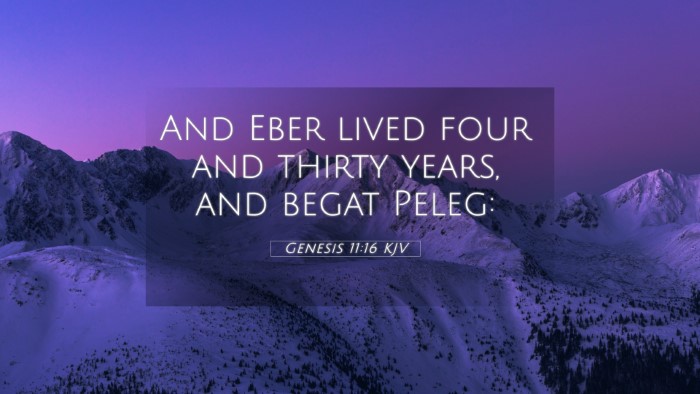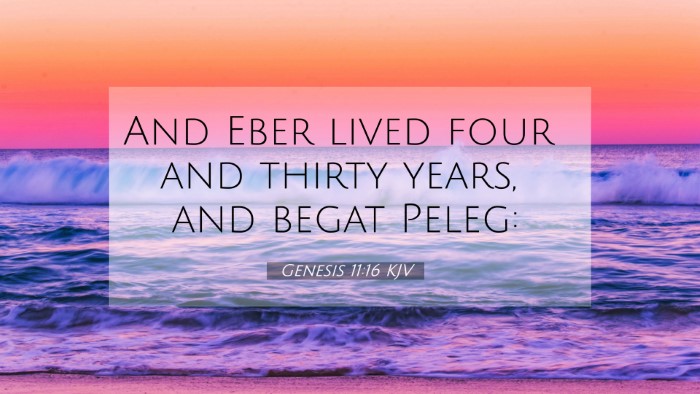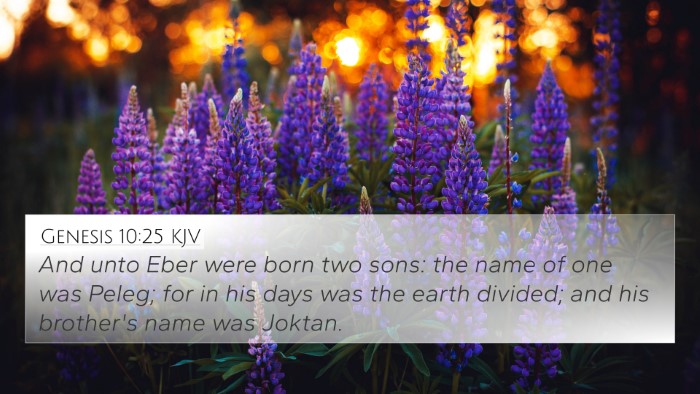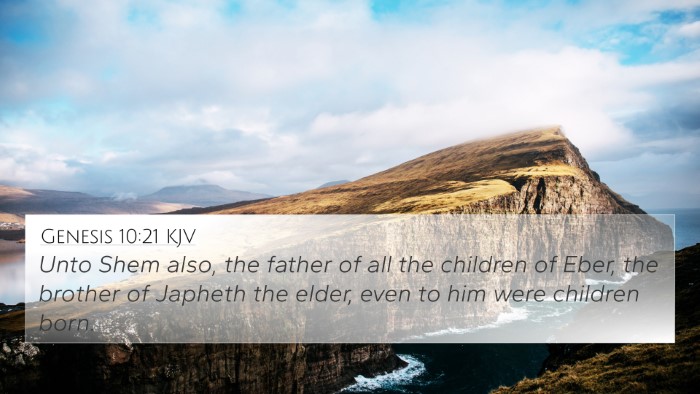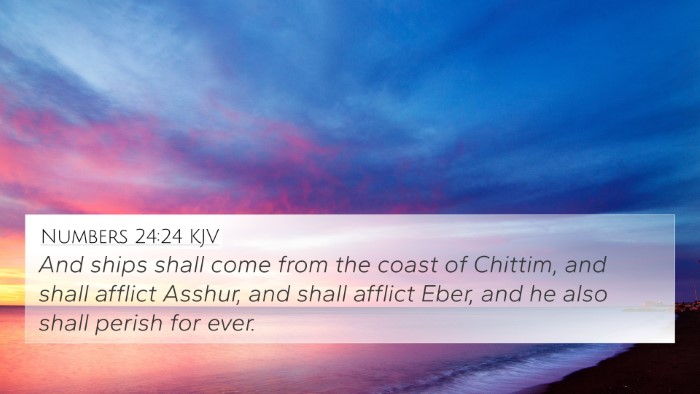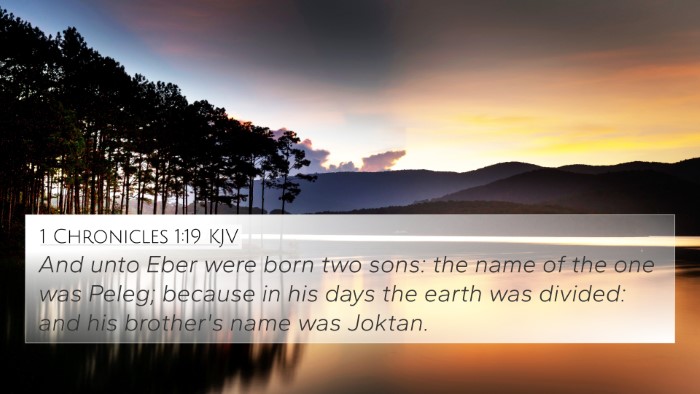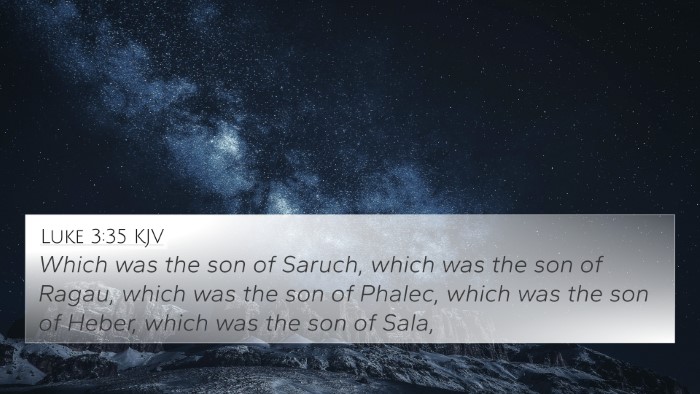Understanding Genesis 11:16
Genesis 11:16 states:
"And Eber lived four and thirty years, and begat Peleg:"
This verse is part of the genealogical record which shows the lineage from Shem to Abraham, filling a significant role in understanding the early human family after the flood.
Insights from Biblical Commentaries
In examining Genesis 11:16, several prominent theological commentaries provide valuable insights:
-
Matthew Henry:
Henry emphasizes the importance of genealogies in Scripture, noting that they serve as a record of God’s covenant with humanity. The mention of Eber, and his descendants, is critical as it leads to Abraham, establishing a clear record of God's plan for his chosen people.
-
Albert Barnes:
Barnes points out that Eber is significant in Biblical lineage because he is the ancestor of the Hebrews. This verse sets the stage for understanding the identity of the Israelites in relation to the broader story of salvation. Peleg's name refers to division, which could foreshadow future divisions among peoples following the Tower of Babel incident.
-
Adam Clarke:
Clarke details the age of Eber and the implications of his name, suggesting that it carries a connotation of being a 'passing over' or a 'crossing.' This may highlight a historical and theological significance as the narrative progresses through the generations to the Israelites.
Thematic Bible Verse Connections
Genesis 11:16 connects to several other scripture passages that focus on genealogies, covenants, and God's plan for his people:
- Genesis 10:21-25: Discusses the descendants of Shem, highlighting the lineage leading to Abraham.
- Genesis 12:1-3: God's call to Abraham, showing the significance of Eber as a key figure in this ancestry.
- Hebrews 7:14: Mentions the lineage of Christ as coming from Judah, connected through these genealogical records.
- Luke 3:36-38: Includes Eber in the genealogy of Jesus, emphasizing the fulfillment of God's promise through these lineages.
- Romans 9:5: References the lineage of Christ, affirming the significance of these genealogical records.
- 1 Chronicles 1:19: Provides additional validation of Eber’s descendants leading to significant Old Testament figures.
- Revelation 7:4: The sealing of the tribes ties back into the lineage established in Genesis.
Cross-referencing Biblical Texts
Understanding Genesis 11:16 involves exploring cross-references that illuminate its meaning:
-
The genealogical context: This verse is embedded in the genealogical lists that establish historical continuity (Genesis 10-11).
-
The significance of Peleg: His name connects to the division of lands and peoples post-Babel (Genesis 10:25).
-
The covenantal theme: The narrative roots back to God's covenant with Noah (Genesis 9:11), showing how God's plan unfolds through generations.
Tools for Bible Cross-Referencing
Several tools can assist in exploring the connections provided by verses such as Genesis 11:16:
-
Bible Concordance: A comprehensive listing of Biblical terms and phrases to find relevant verses.
-
Bible Cross-Reference Guide: Guides that outline relationships between verses in various translations.
-
Bible Reference Resources: Tools that provide access to a broad array of Biblical commentaries and study guides.
Inter-Biblical Dialogue and Comparative Analysis
Genesis 11:16 and its surrounding verses invite further exploration of Old and New Testament connections:
- Identifying themes: One can study the thematic connections from Genesis through to Revelation, revealing God’s continuous plan for humanity.
- Cross-referencing Psalms: Many Psalms reflect upon the covenant promises that trace back to the genealogies in Genesis.
- Comparative study of Pauline epistles: The apostle Paul's teachings often reference Old Testament themes, providing a deeper understanding of their significance.
Conclusion
Genesis 11:16 is not simply a numerical data point in a genealogy; it encapsulates a rich theological narrative that leads to significant redemptive history. By utilizing tools for cross-referencing and connecting relevant scriptures, one can gain profound insights into the unfolding story of God’s covenant relationship with humanity.

